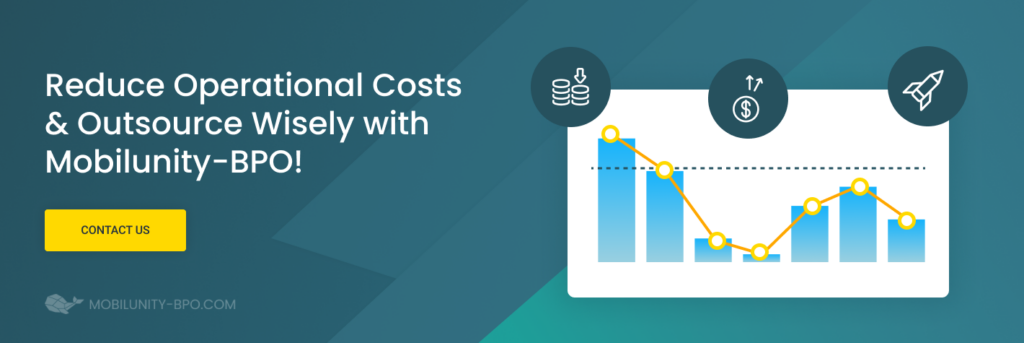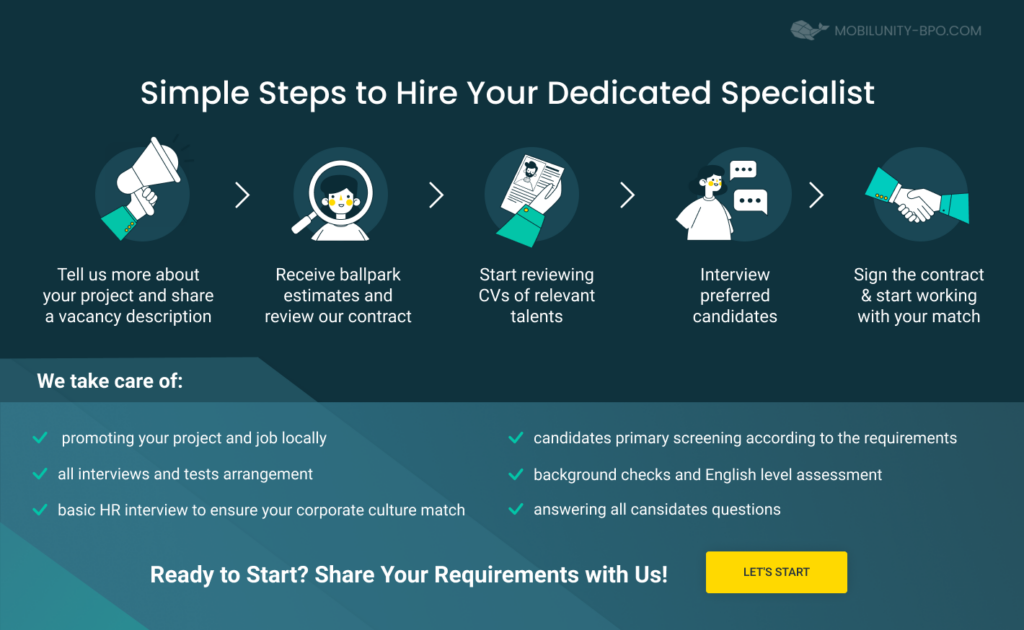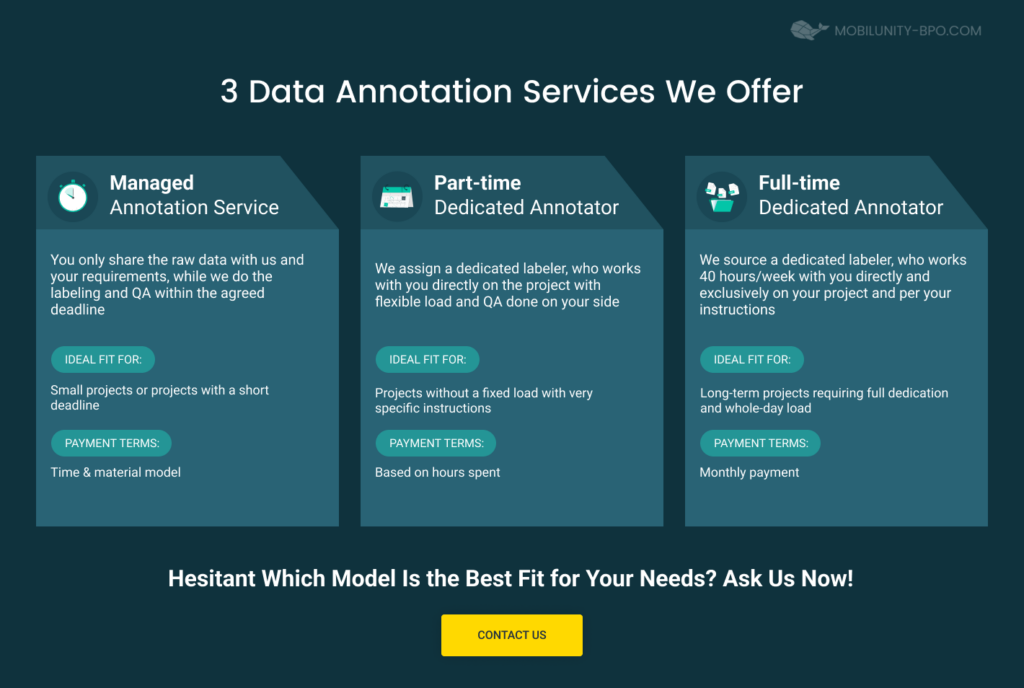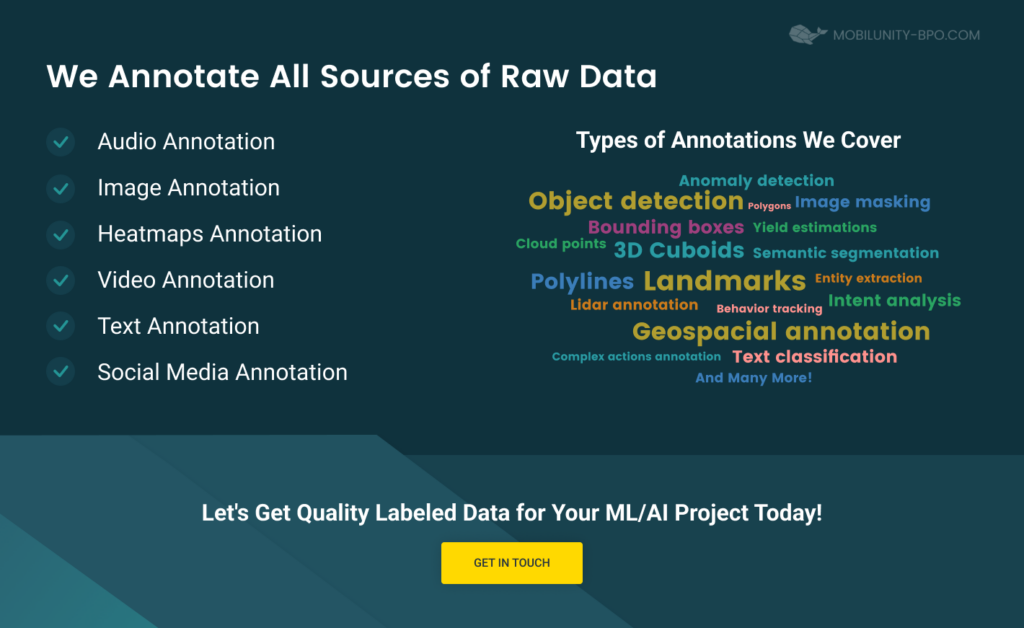Types of Object Labeling Tasks You Can Outsource to Professionals
Data labeling is a key process in building AI models. All artificial intelligence algorithms can’t learn to recognize patterns from raw data. They need specially prepared pieces of information to work with. So, object labeling transforms unprepared data (texts, photos, images) into labeled data, which is easily processed by a neural network.
No matter what AI model you need, label data for machine learning is a required step for your project. A neural network of object detection software can process all types of data: text files, videos, audio, images, etc. But you need to prepare it for the AI algorithms. There are also free datasets of already labeled photos and videos. Unfortunately, they cover only a specific area of tasks. Most business problems still require object detection labeling for building custom AI solutions.
The article explains how a data labeling specialist works. It describes this process’s main types and formats and suggests popular tools and tips for hiring the best engineers to complete the tasks.
6 Object Labeling Types: Brief Description
The examples of image labeling could explain object detection AI training. Let’s check 6 common strategies ML engineers use to make algorithms learn image recognition.
Image Segmentation
It is also known as semantic segmentation. In this case, each pixel on an image corresponds to a class label. For example, road, house, sky, cat, glass, fire, plant, etc. The ML specialist may associate pixels with any semantic class, depending on the meaning of the processed data. This is one of the most popular types of object detection for training brand-new robotics or autonomous vehicles. The thing is, pixel-wise annotation helps algorithms to understand the environment and operate in it properly.
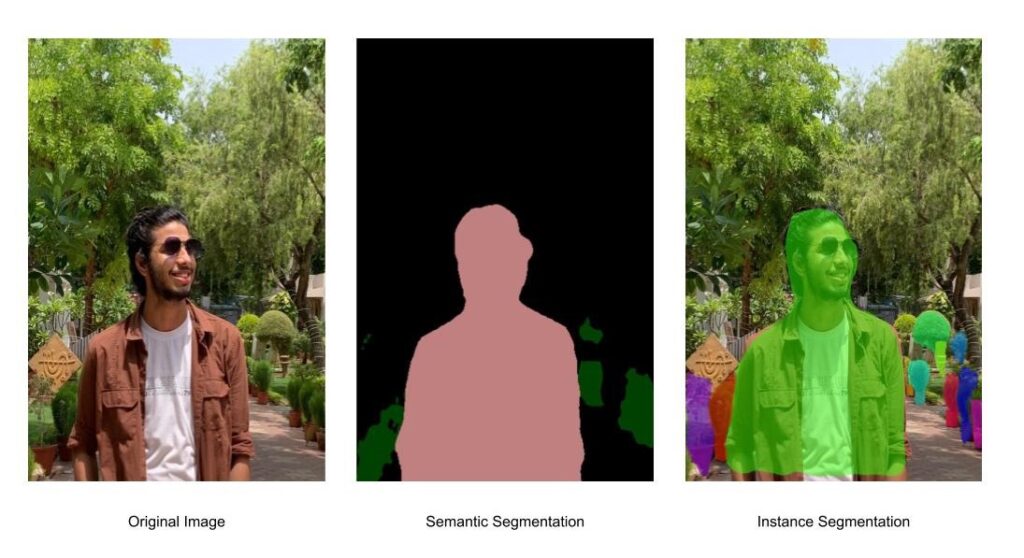
Keypoint and Landmark Annotation
If you need to make AI distinguish minor objects and details, choose this object detection annotation type. The machine creates a sequence of dots across the processed image and recognizes all objects this way. The key-point and landmark object labeling type helps to build AI models for recognizing the human body, facial expressions, emotions, and features. It is widely used by object recognition service provider for security programs, mobile apps, or self-driven cars.
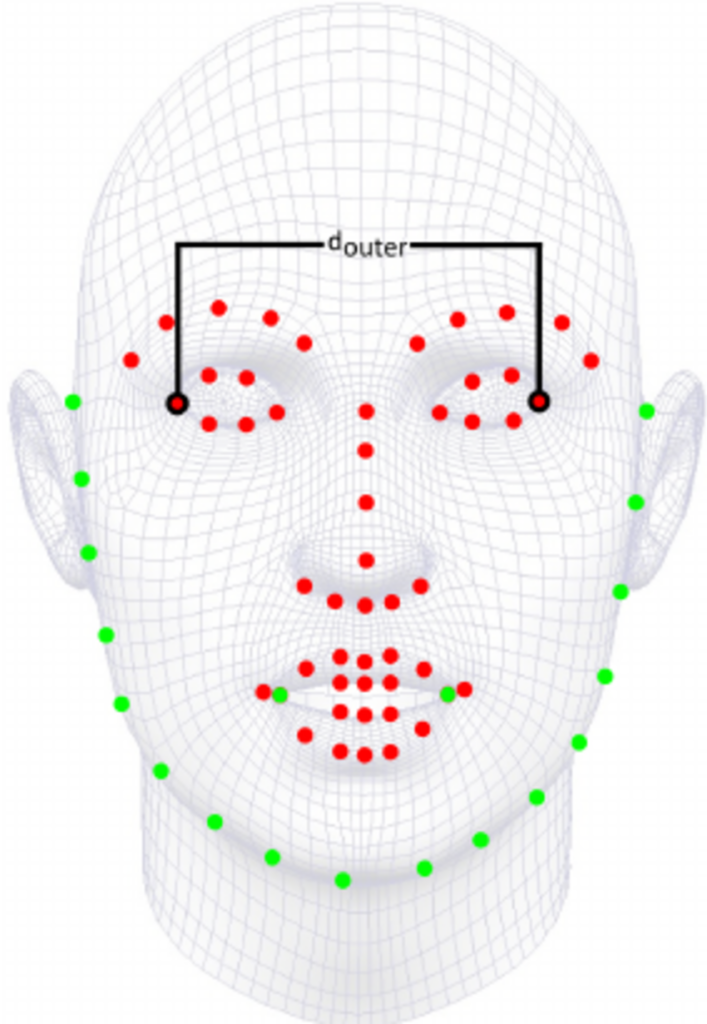
Object Detection Bounding Box
A neural network determines the coordinates of each object on an image, treating them as separate boxes. Each box has its parameters: class, coordinates, width, height, and confidence. The coordinates in the upper-left corner and the lower-right corner of the box are called x1 and y1, x2 and y2. A machine understands the location, size, and correspondence between different objects by these parameters. That’s how annotation format bounding box labeling works. You can see an example of the approach in the picture below.
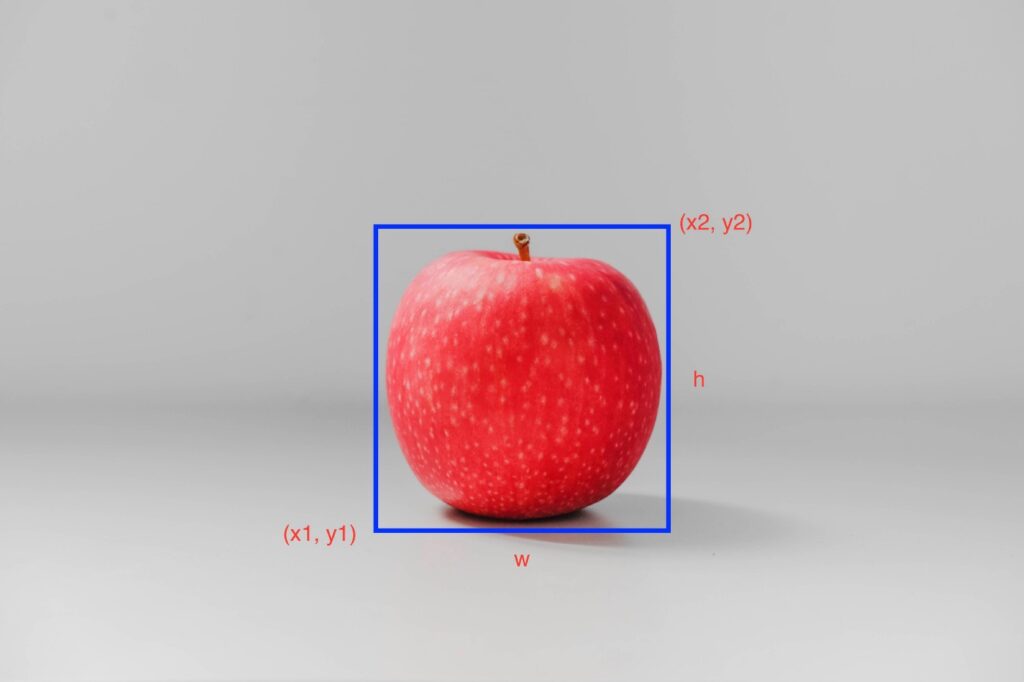
Image Spline Annotation
This object detection annotation format is based on splines and lines that AI distinguishes in the raw data (photos, images). It works perfectly for landscapes, outdoor or interior photos, and architectural projects. An AI algorithm can find lines and treat them as roads (for self-driven vehicles) or conveyors (for automation of manufacturing and other tech processes). The approach is simple yet very effective for the mentioned machine learning tasks.

Polygonal Segmentation
All types of object detection annotation work effectively, depending if they are used to solve business problems for relevant industries. Thus, polygonal segmentation suits the fashion field, online shopping, and cloth design. In this case, a neural network uses complex polygons instead of rectangle boxes. So, it becomes easier to determine the shape of an object and find its location. As a result, ML engineers get a high-quality dataset of human poses and cloth items that they can use to train their AI models.
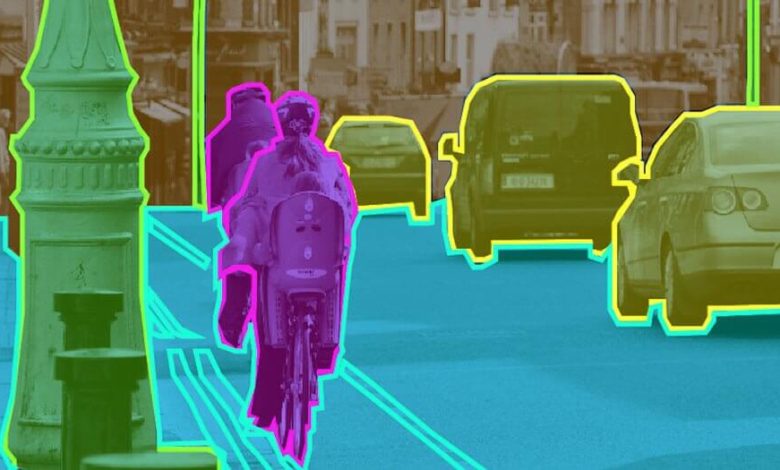
3D Cuboids
Looking at the object detection annotation cubic approach, you may notice it’s similar to the bounding box method. As in the example below, a machine draws a 3D cube over an object. This gives the algorithm additional details about the labeled objects and helps to recognize them more appropriately. It is considered a relevant vehicle object detection annotation type because self-driven robotics need to identify the environment and the surrounding objects in the 3D perspective.
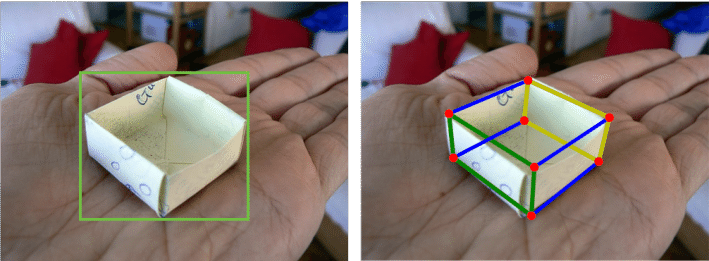
What Are the Most Popular Object Annotation Formats?
Machine learning professionals define not only several types of data labeling processes but also a few formats. There are 3 of them: Yolo, Pascal VOC, and COCO object detection. Each of them could be used, depending on the project’s task and code format standard.
Yolo
The first format is useful when you need to process a huge dataset in a short period. It is also relevant for real-time projects. YOLO is a way to detect and clarify objects in raw data quickly. However, it can miss some details. In this case, a piece of information should be provided as a .txt file and an image. The names of the corresponding files are the same. It is necessary to put a new object on a new line.
COCO
Deep learning engineers use the Common Objects in Context format for most ML projects. This format has 5 object labeling annotation types. They are
- coco object detection annotation format,
- keypoint detection,
- stuff segmentation,
- panoptic segmentation,
- image captioning.
The data is stored in a human-read format, JSON.
Pascal VOC
The last popular dataset format is called Pascal Visual Object Classes. It stores labeled data as an XML file. It demonstrates good performance evaluation on object class recognition but isn’t as widespread as the 2 aforementioned formats.
There are other formats for data labeling in machine learning. Data scientists may use CSV, TFRecords, image masks, etc. When choosing a format, check if your data labeling tool can produce it, as it’s more convenient when you can directly generate annotations in the required format without conversions. This makes the data labeling process fast and simple. If you choose an appropriate object detection labeling tool, check the list below.
Top 5 Object Labeling Tools
Attaching labels to images (or a group of them) requires a professional toolset, that can very useful for outsource image annotation. The brief overview helps to choose an image or video object detection labeling tool for a specific ML project.
- CVAT
The Computer Vision Annotation Tool is a high-quality open-source software with a comprehensive UI and user-friendly design. The tool covers basic data labeling tasks: object detection, image classification, and segmentation. You can use it to process raw data in a photo and video format. Written in React, Python, and TypeScript, this tool corresponds to recent technological trends. You can check the open-source code on GitHub and use it under MIT License.
- Make Sense
The second tool is also free and available on all operating systems. Go to the website and enjoy the perfect user experience without any installations. The program is written in TypeScript, with React and Redux frameworks. It is known as a very quick way of data labeling, significantly saving the ML team time. An engineer can create a dataset and save the prepared data in the required format.
- Label Studio
The famous data labeling tool is universal and suits a lot of different tasks. It can be used to prepare labeled files from videos, photos, audio, text files, and other types of raw data. The simple data labeling tool with a user-friendly UI has many helpful features. For example, it allows downloading data in TSV, CSV, JSON formats, RAR, and ZIP archives. You can also use cloud technologies (AWS S3 and Google Cloud Storage).
- COCO Annotator
Labeling datasets, annotating, and selecting are the tool’s key features, which store data in the popular COVO format. Considering its good security level and simple usage under the MIT license, the tool is recommended for ML teams. It allows training algorithms to detect objects and determine their locations. The tool created by Justin Brooks uses different types of data labeling, which makes it effective for various machine-learning tasks.
- VGG Image Annotator
The last open-source data labeling software can be used offline and supports JSON or CVS file formats. The lightweight tool is quite simple to use and doesn’t require installation. The supported region shapes are rectangles, polygons, point circles, and ellipses. The data labeling tool can be used for educational and commercial data science projects.
Future Trends in Outsourced Object Labeling
As the world steadily marches into a future dominated by AI and machine learning, data labelling services play an increasingly vital role. The outsourcing of object labeling tasks to data labelling companies has emerged as a crucial strategy for organizations, ensuring high-quality inputs for their AI models without compromising their internal resources. In this rapidly evolving landscape, several trends are beginning to reshape the field of outsourced object labeling.
Leveraging AI for Semi-Automated Object Labeling
One prominent trend is the increased leverage of AI for semi-automated object labeling. This hybrid approach, blending human intelligence with machine efficiency, allows data labeling companies to optimize the balance between quality and efficiency.
AI algorithms, trained on large datasets, can handle the initial stages of object labeling, thereby expediting the process. This pre-labeling is followed by the careful scrutiny of trained human annotators, who correct any errors and add the necessary finesse to the labels. This semi-automated process is particularly beneficial when dealing with substantial volumes of data, where manual labeling can become impractical.
Crowdsourcing as a Viable Option for Object Labeling
The concept of crowdsourcing is not new, but its application within the realm of object labeling is an exciting development. It is another trend gaining traction among data labelling service providers. By tapping into the collective intelligence of a large, diverse group of people, crowdsourcing can effectively tackle complex object labeling tasks.
Crowdsourced labeling relies on the principle of wisdom in multitudes, where a diverse set of perspectives can improve the quality and diversity of the labels. With effective quality control mechanisms in place, crowdsourcing can serve as a powerful tool for data labelling services, enabling them to manage labeling projects of any scale and complexity.
Rising Demand for High-Precision 3D Object Labeling
Finally, the escalating demand for high-precision 3D object labeling stands as a testament to the advancements in AI technologies. The advent of self-driving cars, drones, and advanced robotics has necessitated the shift from 2D to 3D object labeling.
High-precision 3D object labeling allows AI models to understand the world in three dimensions, providing depth and context to the objects within a scene. As these technologies continue to evolve, the demand for this intricate form of labeling is set to surge. For any data labeling company aiming to stay at the forefront, mastering high-precision 3D object labeling is becoming an essential requirement.
In the ever-evolving landscape of AI and machine learning, these trends are guiding the trajectory of outsourced object labeling. With the increased leveraging of AI for semi-automation, the application of crowdsourcing, and the growing demand for high-precision 3D labeling, the future of labelling services looks both challenging and exciting. And as these trends continue to shape the industry, they hold the promise of accelerating our progress into an AI-driven future.
Unleashing the Benefits: Outsourcing Object Labeling Tasks
In the era of data-driven decision-making, accurate and reliable data labeling is crucial for training machine learning algorithms. Object labeling, a key component of data annotation, involves identifying and categorizing objects within images or videos. As businesses grapple with the increasing volume and complexity of data labeling tasks, outsourcing has emerged as a viable solution. We will explore the benefits of outsourcing object labeling tasks. From improved efficiency to access to specialized tools, outsourcing can revolutionize data annotation processes and drive enhanced machine learning outcomes.
Before diving further into the benefits of outsourcing, it’s important to understand the challenges faced by service providers in the data annotation domain. This video provides insights into the complexities that arise when offering specialized labeling services, shedding light on the intricacies of the process and the need for expert intervention.
- Outsource Data Labeling: Boosting Efficiency and Scalability
Outsourcing data labeling tasks allows organizations to streamline their data annotation processes and boost efficiency. By leveraging external resources, businesses can scale their labeling operations rapidly to meet growing demands. Outsourcing provides access to a dedicated workforce capable of handling large volumes of labeling tasks efficiently and within tight deadlines. This scalability enables organizations to focus on core competencies while ensuring the timely delivery of accurately labeled data.
- Image Labeling Tool for Object Detection: Enhancing Accuracy and Consistency
Outsourcing object labeling tasks brings the advantage of utilizing advanced image labeling tools specifically designed for object detection. These tools offer automated labeling functionalities, bounding box generation, and annotation verification mechanisms. By outsourcing to service providers equipped with these tools, organizations can achieve higher labeling accuracy, consistency, and adherence to labeling standards. The utilization of image labeling tools enhances the overall quality of labeled datasets.
- Outsource Image Labeling: Access to Specialized Expertise
Outsourcing image labeling to specialized service providers grants organizations access to a highly skilled workforce experienced in object recognition and annotation. These experts possess domain-specific knowledge and can accurately label objects based on defined criteria. Leveraging their expertise ensures superior quality annotations and minimizes errors, contributing to the successful training of machine learning models.
- Object Labeling Outsourcing: Cost Optimization
Outsourcing object labeling tasks can offer cost optimization benefits for organizations. By outsourcing, businesses can avoid the expenses associated with recruiting, training, and managing an in-house labeling team. Service providers often operate on a pay-per-task or pay-per-hour basis, providing cost predictability and flexibility. This cost optimization enables organizations to allocate their resources more efficiently and invest in other critical areas of their operations.
- Video Labeling Services: Tackling Complex Annotation Requirements
For organizations dealing with video datasets, outsourcing video labeling services can be highly advantageous. Video annotation involves tracking and labeling objects across frames, requiring specialized skills and meticulous attention to detail. By leveraging the expertise of service providers experienced in video annotation, businesses can ensure accurate and consistent labeling of objects in dynamic video sequences, improving the quality and reliability of training data for video-based applications.
- 3D Cube BPO: Catering to Three-Dimensional Data
In certain industries, such as autonomous driving and robotics, three-dimensional data annotation is essential. Outsourcing to a 3D Cube BPO (Business Process Outsourcing) provider offers the expertise to handle complex 3D object labeling tasks. These providers employ advanced tools and techniques to annotate point clouds, depth maps, and LiDAR data accurately. Outsource data annotation ensures the generation of high-quality training datasets for advanced computer vision applications.
- Data Labeling Outsource: Focus on Core Competencies
By outsourcing data labeling tasks, organizations can redirect their internal resources and expertise toward core competencies and strategic initiatives. Outsourcing allows businesses to leverage external proficiency in data labeling, freeing up valuable time and resources for activities that directly contribute to their core business objectives and growth.
Outsourcing object labeling tasks offers a multitude of benefits, including increased efficiency, access to specialized tools, enhanced accuracy, cost optimization, and the ability to focus on core competencies. Leveraging outsourcing for data labeling empowers organizations to tackle complex annotation requirements, such as video and three-dimensional data, with expert assistance. By embracing outsourcing as a strategic approach, businesses can elevate the quality and reliability of their training datasets, ultimately leading to improved machine learning outcomes and driving their success in the data-driven landscape.
Why Delegate Object Labeling to Professionals?
Object detection annotation is a common task in developing various software products. ML engineers use this fundamental process to create apps for HealthTech, geo-sensing, aerial imagery, precision agriculture, and autonomous vehicles. Regardless of your company’s business domain, your ML team will likely have many significant tasks. That’s why outsourcing object labeling is a reasonable solution.
Let’s check why this machine learning outsourcing service can improve the quality of the results of your ML team.
1. Data Labeling Influences the Success of the Whole Project
Making prepared datasets from the raw data is one of the basic steps in machine training. To solve specific data science tasks, you need custom databases. Their quality directly influences the future deep learning of computer vision. So, this step should be appropriately done and held by true professionals.
2. Object Labeling Requires Specific Expertise and Tools Knowledge
An experienced data labeling specialist can choose the best way to solve your business problem. They know what data labeling type works better in each case because of more experience than a multitasking ML engineer. Furthermore, they can consult you about tools to apply or formats for data storage in your project. So, you will be sure that the neural network will have a relevant database for effective learning.
3. Data Labeling Outsourcing Allows the ML Team to Focus on the Main Tasks
Object labeling is just the beginning of any deep-learning project. It’s a minor task. Your team has high-level priorities for sure. As this is a time-consuming process, data labeling outsourcing sounds like a good idea. Thus, your high-skilled specialists won’t switch between different tasks and will feel more comfortable. As a result, the whole team meets deadlines and has good performance.
How to Get Mobilunity-BPO Data Labeling Services?
If you decide to outsource the data labeling tasks, ensure you have a reliable partner for the project. Mobilunity-BPO is ready to provide high-level machine learning and software development professionals. The company has 10+ years of experience hiring top-ranked engineers for various requests. You can get a dedicated ML engineer to join your team daily or receive AI data labeling services just for one short-term project.
The possible formats of cooperation:
- a dedicated specialist who integrates into your team for a lasting project and works 40 hours per week
- a dedicated specialists, but working part-time on your project (20-30 hours per week)
- data labeling of a specific dataset, short-term collaboration.
Besides flexibility and a client-centered approach, Mobilunity-BPO has several strengths as an outsourcing provider of IT services.
- Rich experience and good expertise
The cases, client reviews, and top industry ratings emphasize the company’s great results. It is rewarded by Clutch.co and other global listings. Mobilunity-BPO has over 1,000 completed projects for clients in 15+ countries.
- Clear processes and perfect communication
Both the sales and delivery processes are transparent for the clients. The company knows how to organize efficient processes in detached, remote multicultural teams.
- Ability to hire high-skilled professionals in short terms
Having many years of experience and a good professional network, Mobilunity-BPO is ready to find top talents for your team. The hiring process is smooth and doesn’t require a lot of time.
That’s how Mobilunity-BPO builds trustful business relations and has provided exceptional IT outsourcing services for over a decade. Join 40+ companies that already have skilled engineering professionals on their teams! Save your time and get better results by hiring data labeling specialists with Mobilunity-BPO.
